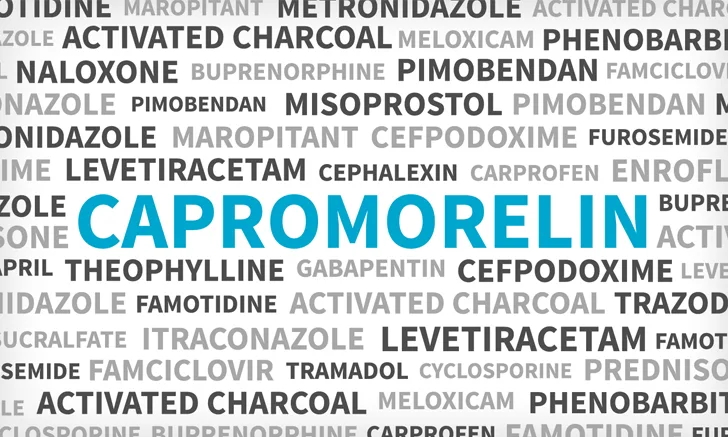Capromorelin

Appetite Stimulant (Systemic Drug)
Prescriber Highlights
FDA-approved to stimulate appetite in dogs
Ghrelin receptor agonist that stimulates hunger
Diarrhea, vomiting, polydipsia, or hypersalivation may occur
Uses, Indications
Indicated for stimulation of appetite in dogs; experiential data is limited mostly to clinical study patients
In a laboratory setting, capromorelin (compared with placebo) increased food consumption and body weight in healthy cats, but capromorelin is not yet FDA- approved for use in this species
Contraindications, Precautions, Warnings
Contraindications
Patients with hypersensitivity to capromorelin or its components
Precautions
Patients with renal insufficiency or hepatic dysfunction
Warnings
Capromorelin use has not been evaluated in breeding, pregnant, or lactating bitches
Side Effects
GI distress (nausea, vomiting, diarrhea, hypersalivation, flatulence, abdominal pain)
Polydipsia
Lethargy
Potential increases in BUN and serum phosphorous concentrations
Drug Interactions
No interactions are currently reported
Capromorelin is metabolized by CYP3A4 and CYP3A5, so interactions with CYP3A4 inducers (eg, phenobarbital, rifampin) and inhibitors (eg, diltiazem, erythromycin, cimetidine, amiodarone, ketoconazole, itraconazole) may increase or decrease metabolism
Monitoring
Clinical efficacy, adverse events
Body weight
Client Information
Gently shake the bottle before use; rinse the syringe between doses
Drooling and vomiting may occur shortly after administration
Dosage Forms
The following product is labeled for veterinary use:
Capromorelin flavored solution: 30 mg/mL in 10 mL, 15 mL, or 30 mL bottles
‒Compiled and summarized from Plumb’s® Veterinary Drugs by Shannon Palermo, VMD
Information about this drug was adapted from Plumb’s® Veterinary Drugs. Further details and more therapeutics can be found with a subscription at www.plumbsveterinarydrugs.com